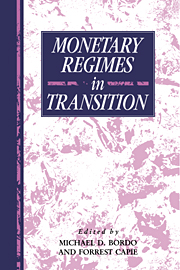Book contents
- Frontmatter
- Contents
- List of figures
- List of tables
- List of contributors
- 1 Introduction
- Part I Commodity money standards in transition
- 2 The scramble for gold: monetary regime transformation in the 1870s
- 3 The Latin Monetary Union and the emergence of the international gold standard
- 4 Greenback resumption and silver risk: the economics and politics of monetary regime change in the United States, 1862–1900
- Part II Successful and unsuccessful adherence to the gold standard
- Part III Wartime upheaval and postwar stabilization
- Part IV Perspectives on monetary regimes
- Index
4 - Greenback resumption and silver risk: the economics and politics of monetary regime change in the United States, 1862–1900
Published online by Cambridge University Press: 05 May 2010
- Frontmatter
- Contents
- List of figures
- List of tables
- List of contributors
- 1 Introduction
- Part I Commodity money standards in transition
- 2 The scramble for gold: monetary regime transformation in the 1870s
- 3 The Latin Monetary Union and the emergence of the international gold standard
- 4 Greenback resumption and silver risk: the economics and politics of monetary regime change in the United States, 1862–1900
- Part II Successful and unsuccessful adherence to the gold standard
- Part III Wartime upheaval and postwar stabilization
- Part IV Perspectives on monetary regimes
- Index
Summary
Introduction
An enduring contribution of macroeconomic theory in the 1970s and 1980s was its emphasis on the role of expectations of future behavior in causing current movements in asset and commodity prices. While this approach had been applied to the valuation of stocks and bonds, the contribution of recent macroeconomics has been to translate the asset-pricing approach to the problems of understanding movements in exchange rates and price levels by taking explicit account of policy processes and agents' expectations (Muth, 1961; Sargent, 1973; Dornbusch, 1976; Krugman, 1979; Sargent and Wallace, 1981; Flood and Garber, 1983, 1984; Obstfeld and Rogoff, 1983; Obstfeld, 1986; Grilli, 1986, 1990). In particular, these models showed that a complete analysis of the price and exchange rate processes requires an explicit description of the money-supply process, and explicit modeling of anticipations of possible switches in monetary regimes. In a fixed exchange rate regime, promises of convertibility will be convincing only if government reserve holdings and long-run fiscal policy make those promises credible. Uncertainty regarding future monetary regimes was a central feature of American political and economic life in the second half of the nineteenth century. From 1862 to 1879 the United States operated on a greenback standard with no convertibility maintained between the greenback and gold. Following a decade of bitter political struggle over resumption of convertibility, the greenback became convertible into gold in January 1879. But after resumption of convertibility, a new threat to the dollar emerged in the form of the “free-silver” movement. The goal of this movement was to re-establish a bimetallic standard, which would have led to a defacto switch to a depreciated silver dollar standard. These struggles were the defining characteristics of party platforms and national political campaigns.
- Type
- Chapter
- Information
- Monetary Regimes in Transition , pp. 86 - 132Publisher: Cambridge University PressPrint publication year: 1993
- 2
- Cited by



